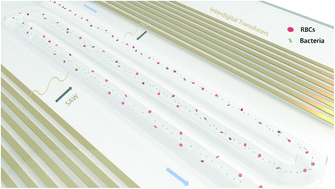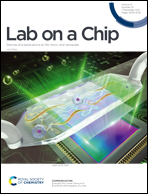A microfluidic chip with a serpentine channel enabling high-throughput cell separation using surface acoustic waves†
Abstract
As an acute inflammatory response, sepsis may cause septic shock and multiple organ failure. Rapid and reliable detection of pathogens from blood samples can promote early diagnosis and treatment of sepsis. However, traditional pathogen detection methods rely on bacterial blood culture, which is complex and time-consuming. Although pre-separation of bacteria from blood can help with the identification of pathogens for diagnosis, the required low-velocity fluid environment of most separation techniques greatly limits the processing capacity for blood samples. Here, we present an acoustofluidic device for high-throughput bacterial separation from human blood cells. Our device utilizes a serpentine microfluidic design and standing surface acoustic waves (SSAWs), and separates bacteria from blood cells effectively based on their size difference. The serpentine microstructure allows the operating distance of the acoustic field to be multiplied in a limited chip size via the “spatial multiplexing” and “pressure node matching” of SSAW field. Microscopic observation and flow cytometry analysis shows that the device is helpful in improving the flow rate (2.6 μL min−1 for blood samples; the corresponding velocity is ∼3 cm s−1) without losing separation purity or cell recovery. The serpentine microfluidic design provides a compatible solution for high-throughput separation, which can synergize with other functional designs to improve device performance. Further, its advantages such as low cost, high biocompatibility, label-free separation and ability to integrate with on-chip biosensors are promising for clinical utility in point-of-care diagnostic platforms.

- This article is part of the themed collection: Lab on a Chip HOT Articles 2021


 Please wait while we load your content...
Please wait while we load your content...